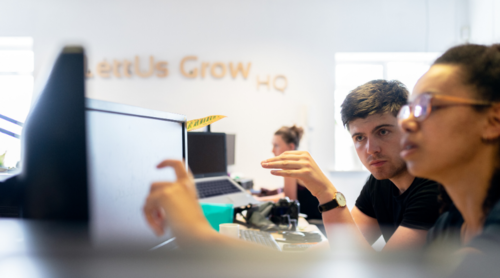.png)
Achieving diversity in the workforce 4 common challenges
Today, diversity in the workforce reflects the growth of an organisation, and is essential in these difficult times brought on by theCovid-19health and economic crisis as having a diverse workforce can lead to more innovative ideas, and foster a more productive work environment which is essential in a crisis management situation.
It is also widely agreed that diversity empirically expands the recruitment range of a company to a greater variety of talent. Although the concept of diversity is widely preached, it is important to also highlight the common challenges that will be faced in the process of achieving diversity in the workplace. Here at half the sky we have put together the four common challenges in achieving the long march for diversity in the workforce.
1. Gender differences

Gender diversity is probably one of the largest challenges in the workplace today. As society rapidly evolves so do cultural beliefs and perceptions however, in some societies and cultural groups a womens role is seen as homemakers or in other "traditional female" occupations. Corporations play an integral role in fighting these entrenched beliefs and perceptions. According to aWorld Economic Forum Global Gender Gap report from 2018, the gender pay gap in South East Asia will take over 70 years to reach parity; that is only if the current paying rates were maintained. This could be setback even further due to the economic crisis which could impact women far greater.
Good news is that policy makers and stakeholders are putting more effort than ever to achieve gender equality. Moreover, companies have also been taking the initiative to hire more women in positions of leadership and make concerted efforts to hire women across the fields of Science Technology Engineenring Mathermatics (STEM). These measures are significant to fast-forward the closure of the preceding gender pay gap and slowly erode notions of women being less capable than men, in the workplace..
2. Generational differences

Many experts agree that there are typically four different generations in the office – Veterans, the Baby Boomers, Generation X, and Generation Y. However, a new entrant into the workforce Generation Z is emerging and changing the composition of the workplace. The challenges for organisations to develop a harmonious workforce of five generations of workers with very different values and work habits is immensely challenging.
As, generational turn-over at a workplace is longer with more older workers remaining in the workforce it is essential to bridge the divide between multiple generations of workers. Misunderstandings and confusion tend to take place between generations whether at home or at the workplace. Each generation shares a different perspective of the world; each has their preferred way of managing, and being managed. The older generation typically prefers to be appreciated for their life and work experiences, while the younger prefers to be acknowledged for their achievements. This is a growing challenge towards diversity that each company will have to overcome, and a good way to overcome it is to understand and analyse each generation’s strength, weakness, opportunity and help each to appreciate what the other can contribute.
3. Ethnic and cultural differences

Diversity has created a broader racial spectrum at work, bringing people from all walks of life under the same company in the pursuit of a shared value and purpose. In today’s globalized world it is a crucial challenge towards attaining diversity as a whole. It is expected for individuals to bear some inherent unconscious biases and prejudices towards others of a different ethnicity and culture, especially when facing one another for the first time. However, such negativity should not be practised in any professional work environment, as it creates huge roadblocks for an the organisation to thrive.
Therefore, leaders should play pivotol roles in embracing ethnic and cultural diversity at work, and carefully consider the intolerances that may occur among employees; cultivate an environment of acceptance, understanding and respect, and a zero-tolerance attitude against discrimination. Without strong leadership on this issue deeply held biases by managers could impact a companies ability to hire the best talent, or promote the right talent and most importantly retain the talent that they already have.
4. Backlash agaisnt diversity

As we have started 2020 managing a global pandemic many organisations may seek to put diversity on the backburner, and a small proportion of the workforce may applaud this as they find topics on diversity emotionally polarizing, and may even view the very concept of diversity in a negative way.
As topics on diversity have generally become more accepted in the workplace, it is natural for the extreme edges of the workforce to harbour some resistance to the inevitable change that it will bring. It is essential for corporations to react positively and listen to these voices; identify and address their problems, to create a more dynamic and consensus led diversity agenda in the workplace. If not, the backlash will worsen and resistance will increase holding back organisations to achieving the optimal workforce.
The corporate world has been shaken up by the crisis of Covid-19 from lockdowns, remote working, travel bans and others – and in the midst of this current crisis companies may be focused on the immediate economic fallout that this crisis will inevitably bring. However, neglecting the transformation to a more diverse organisation will have a long-term negative impact – as diversity shows its strengths especially during a crisis. As the more diverse a company, the more workers have to learn to perform successfully as a team, the more innovative ideas you can access to address specific problems, the more you can attract the best talent especially when we have an economic recovery.
Enjoyed this article? Let us know your thoughts in the comments below:
Blogs for you
Half the Sky's mission is to supply the tools that can give every woman the ability to build a successful career and be fully prepared for the future of work. So, that they can lead a healthy, prosperous and more balanced/blended lifestyle of their choosing. By building your confidence, you’re setting foundations to empower yourself and your career. The world is your oyster, and it starts with you.
Enjoyed this article let us know your thoughts in the comments below:
About half the sky
half the sky (HTS) is a career platform for women connecting you to career opportunities at companies that care. Providing you with information, tips and strategies to navigate the rapidly changing workplace.
Sign up to get career tips and job alerts directly to your inbox! Join us to shape the future of women at work together!



